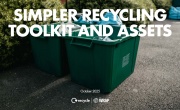Lockdown hits RDF market
The third wave of COVID has hit the waste industry, introducing new and serious challenges. Signs are that 2021 will be a tough year for the European EfW sector, argues COO Ralf Schöpwinkel at Geminor
COVID turned 2020 into a year we will never forget. But even though the pandemic was a considerable shock to the system, the waste industry across Europe showed the ability to adapt and solved most of the challenges introduced by COVID. In fact, many industry players experienced growth in 2020 despite a turbulent waste market. And by the end of the year – with new vaccines being introduced at a record-breaking speed – most of us hoped for better days and a relatively quick normalisation.
A few months into the new year, and we can conclude that this will not be the case. An increase in the spreading of the coronavirus all over Europe – mainly triggered by a Christmas break and several mutated variants – has led to the most serious European lockdown so far.
 This has meant a repeat of spring last year. Low economic activity results in less commercial and industrial waste (C&I) for energy recovery – not to mention a reduction of material for recycling across Europe. In January alone, waste fuels for operators were far below expected volumes, and the trend continued into February. Waste exporting countries such as the UK, Germany, and Norway are not only producing less residual waste for incineration, but they are also utilising more of their own volumes, making the surplus available for export reduced to a minimum. Not only residual waste, but also the streams of paper and waste wood are affected.
This has meant a repeat of spring last year. Low economic activity results in less commercial and industrial waste (C&I) for energy recovery – not to mention a reduction of material for recycling across Europe. In January alone, waste fuels for operators were far below expected volumes, and the trend continued into February. Waste exporting countries such as the UK, Germany, and Norway are not only producing less residual waste for incineration, but they are also utilising more of their own volumes, making the surplus available for export reduced to a minimum. Not only residual waste, but also the streams of paper and waste wood are affected.
C&I is now reduced considerably, but just as important is the fall in construction and demolition waste (C&D), which is an important part of the waste volumes exported within Europe every year. COVID has stopped construction workers from moving freely across borders, reducing the activity in the industry. The volumes of municipal solid waste (MSW) are fairly consistent, also at the start of 2021, but for waste operators, this has not offset the reduction of C&I and C&D.
Dynamics of Brexit and taxation
 This article was taken from Issue 100
This article was taken from Issue 100Another issue that affects the current market situation, is the ongoing and varying CO2 and incineration taxation across Europe. Different taxation in different markets leads to turbulence and change of long-lasting waste streams. The current lack of waste fuels in the market impacts the gate fees, which in turn is a challenge for off-takers with increasing taxation and operational costs.
The best example of this market issue is the present UK situation. The increased national incineration capacity, combined with a reduction of waste volumes, is changing the game. When the gate fee for export to Europe is close to £95-100 per tonne, the national market has a gate fee of only £75-90. Waste is a price-sensitive commodity, and both the economic interests and the understanding of the market situation differ greatly from one end of the value chain to the other.
In addition to these challenges, both Brexit, COVID, and current global shipping issues have affected the availability of bulk transport in Europe. This is particularly a challenge for bulk ship transport in northern Europe, making it both more expensive and less secure due to the reduction of ship capacity.
The start of 2021 more than ever proves the importance of diversity both within available waste markets and logistics solutions. If one market struggles to deliver, another must be ready to supply. At present, countries such as Poland, Italy, and France are beginning to increase their market share in waste volumes for export, making up for some of the lost volumes. And finally, good medicine for a turbulent market would also be more aligned tax regulations among EU and EEA countries, allowing for more predictability within the industry. Together, these factors are important in handling challenges of “epidemic scale”.






